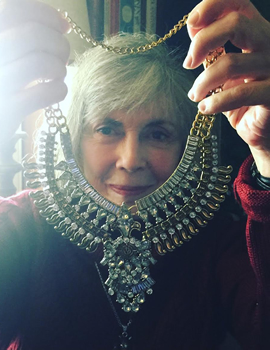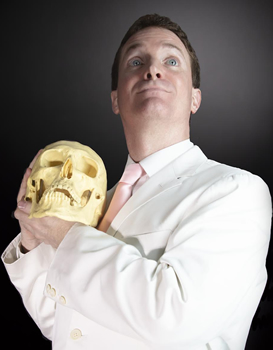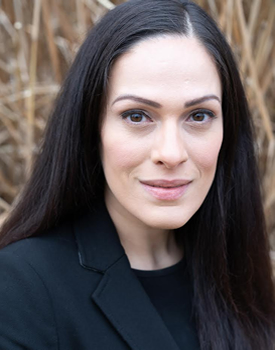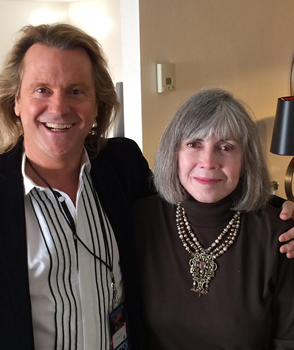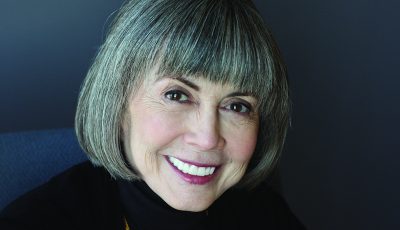

ICONS: Anne Rice
Honoring the Author Who Reinvented Horror
When Anne Rice submitted her first novel to publishers in 1973, her experience would’ve been familiar to countless aspiring writers: No agent wanted to represent it, and no publishing house would touch it. Rice’s fortunes soon changed at a writers’ conference, where she landed an agent and attracted the attention of an editor at Knopf. Things happened quickly from there: Knopf offered Rice a $12,000 advance—the equivalent of about $75,000 in today’s market, and significantly more than most debut authors were making—and Rice was on her way to becoming a published novelist.
But Knopf’s generous advance was nothing compared to what lay in store for Rice. Her manuscript—a modernized take on Gothic horror tales called Interview with the Vampire, which Rice wrote to cope with the unimaginable grief of losing her young daughter to a rare form of leukemia in 1972—soon became the talk of the publishing world. With paperback rights still up for grabs, editors all over New York were scrambling to get their hands on a Xeroxed copy of Rice’s book. A major mail-order book club chose Interview as one of their selections, and Paramount ponied up $150,000 for the motion picture rights. After a heated bidding war, Ballantine shelled out $700,000 for the book’s paperback rights—nearly $4 million today, if you’re keeping track—all before Interview was even published. Rice agreed to a substantial rewrite to improve her book’s structure and make its plot more dynamic, but she believed so strongly in her voice that she rejected nearly all of the copy edits that would’ve streamlined what would become her signature, sometimes baroque style.
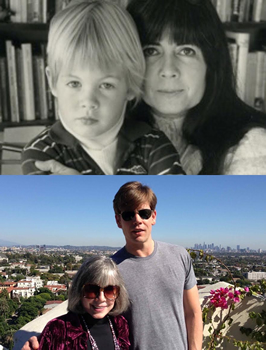
Top: Anne and her son Christopher in 1985, in Anne’s office in San Francisco’s Castro District (where she wrote 1982’s Cry to Heaven and 1985’s The Vampire Lestat). On the bottom, Anne and Christopher in 2013, on the roof deck of the Sunset Tower Hotel in West Hollywood.
Rice’s confidence was richly rewarded. Over the next 47 years, Rice would author more than 30 books and sell more than 150 million copies worldwide. Her Vampire Chronicles spawned a blockbuster film, became a foundational text of the goth subculture, and forever changed how vampires were depicted in books, movies, comics, music, and television.
Rice died of complications from a stroke on December 11, 2021, but the worlds she created continue to expand. Anne Rice’s Mayfair Witches is in development at AMC, and the network will premiere Anne Rice’s Interview with the Vampire later this year. On the publishing front, last month saw the release of Ramses the Damned: The Reign of Osiris, co-authored by Rice and her son, bestselling novelist and producer Christopher Rice.
To celebrate Rice’s extraordinary life, The Big Thrill has assembled a panel of authors who have carved out careers in a horror genre forever altered by Rice’s work: Grady Hendrix, the New York Times-bestselling author of The Southern Book Club’s Guide to Slaying Vampires, The Final Girl Support Group, and the upcoming How to Sell a Haunted House; Alma Katsu, the Stoker and Locus Award-nominated author The Deep, The Hunger, the 2022 Thriller Award-nominated Red Widow, and the upcoming The Fervor; Cynthia Pelayo, International Latino Book Award winning and three-time Stoker Award-nominated poet and author of Children of Chicago; and Gemma Files, the Shirley Jackson Award-winning author of Experimental Film and the Hexslinger Series.
What was your first experience with Rice’s work, and what kind of impression did it make?
Alma Katsu: It was a paperback copy of Interview that my sister’s best friend lent to me. I must’ve been in my late teens. I was a literary snob then, mostly reading literary fiction. Interview knocked my socks off. I didn’t stop thinking about it for years.
Grady Hendrix: I struggled through Interview with the Vampire in high school and really found it a chore. Against my better judgment I picked up The Vampire Lestat and it hooked me in the first chapter. I plowed through it and went back to re-read Interview, pretty much skimming the parts without Lestat. It’s hard to describe what an antidote Lestat was to the average vampire at the time, most of whom were dominated by Stephen King’s evil and animalistic vampire Barlow in ’Salem’s Lot. Lestat was funny, accessible, elegant—pretty much the perfect boyfriend.
Cynthia Pelayo: It was her iconic 1976 novel, Interview with the Vampire. I was probably too young to have been reading it at the time, but I was completely immersed in the story, and invested in those characters. Then to see them translated into film when I was a teenager, I was completely mesmerized. I needed to know everything about Anne Rice and to consume all of her work that I could. I knew reading it and I knew in watching the film adaptation what was happening before me was something very special.
Gemma Files: Like a lot of people of my age, probably (I was born in 1968), I first encountered Anne Rice when I stole my mom’s copy of Interview with the Vampire from her bedside table and read it in breathless snatches (so to speak). Anne Rice was to me what Flowers in the Attic was to most other pre-Internet tweens—a source of not particularly accurate information about adulthood and queer sexual vibes “tainted” with extreme dub-con shading. Like Bram Stoker said, I lay back and waited, waited with a beating heart.
Interview with the Vampire earned Rice hundreds of thousands of dollars before it was even published, racked up moderate sales with its hardcover release in 1976, then became a bestseller with its paperback release the following year. Why do you think people responded so strongly to it?
GH: From what I understand, Interview did well, but what made Anne Rice a household name was the release of The Vampire Lestat in 1985, which was a blockbuster right out of the gate. Leaving aside the fact that Lestat is a much more appealing character with his leather pants and his rock band, whereas Interview’s Louis just whines a lot, what changed between Interview and Lestat was AIDS. It’s hard to remember how hysterical we got over AIDS, but you had mostly gay people dying in large numbers of an incurable disease that stigmatized them, and you had mostly straight people getting court orders to put HIV+ children in cages. You had serious talk about tattooing HIV+ adults. You had families abandoning the corpses of their HIV+ sons, leaving them to be buried by strangers. Sex education consisted of terrifying teenagers about bodily fluids. We were told that sex was over, that skin-to-skin contact equaled death, that kissing could kill you. Into the middle of this insanity comes Anne Rice and her vampires who wallow in bodily fluids, who don’t practice safe sex, who are a persecuted, hidden minority who are sexier, funnier, more interesting, and better dancers than everyone else. Her vampires looked like a direct response to the anti-sex homophobia of mainstream culture, and so her vampires became a life raft for a lot of marginalized people who wanted to see themselves not just reflected but refracted into an image that was stronger and more powerful than they were in reality.
CP: That first line alone draws you in: “I see…” said the vampire thoughtfully, and slowly he walked across the room towards the window.
That moment you read that first line you are immediately with the vampire. There’s no build up like in previous vampire novels for the big reveal of who is the vampire and what is their motivation. You are immediately in the room with the vampire in that first line, and that’s both alluring and terrifying.
At least up until then, fiction surrounding the vampire focused on the vampire as this outsider infecting and terrorizing a community, but Anne Rice sat us right down with the vampire in an interview in which we were able to gain complete insight into not just the lore surrounding them, but the span of their life. It was absolutely captivating, and what Rice did there continues to influence fiction that showcases the vampire as this monster that we can almost relate to.
GF: There’s this other line (remembered rather than quoted) from A Dream of Dracula: In Search of the Living Dead by Leonard Wolf, which I also read way too early, as part of my gradual horror awakening: Dracula is a fantasy of power without accountability, pleasure without risk; he says I will rape you with my mouth and you will love it. A lot of adolescents receive the wisdom that their sexual urges are somehow dirty/guilty, so the vampire fantasy of exchanging a moment’s being preyed upon for an infinite lifetime of freedom and predation, of passing on the virus and making “children” without having to physically alter yourself, holds a lot of weight. Vampires were my gateway drug, gradually widening the window into everything that scared me most: pain, grief, death. They dance around the idea of love, which is innately risky—they’re evil angels, swooping down on us from above. Rice absolutely bottled that shit for wide cultural consumption, but I think we’d definitely been waiting for it—all the default people, the people who felt locked out of the heteronormative pattern: queer people, kinky people, POC, non-cis people, women who didn’t want to be defined by their biology. Then Clive Barker arrived, and things broke wide open, at least for me.
Grady, you’re an expert on the paperback horror boom of the ’70s and ’80s, as evinced by your indispensable book Paperbacks from Hell. Can you help us position Interview with the Vampire in the context of that boom? What was the horror fiction landscape like in 1976-77, when Interview was published?
GH: Melissa Singer, who started editing at Tor in the ’80s, says that there are horror novels, whose sales come in cycles, and then there are vampire books, and they always sell. In the ’70s, vampires were over. The Hammer films were desperate, gimmicky, and pretty much over; vampire books were either the Gothic soap operas of Marilyn Ross’s Dark Shadows tie-in series, which had ended in 1972, or they were parodies. There were occasional good books like Fred Saberhagen’s Dracula Tapes, but they were rare. Then came the one-two punch of Stephen King’s ’Salem’s Lot in ’75 and Anne Rice’s Interview with the Vampire in ’76, and the whole genre got enough gas in the tank to make it to the ’80s. Whitley Strieber’s The Hunger came out in ’81 and a few others, but it was The Vampire Lestat in 1985 that really sent vampires into overdrive. The trickle turned into a geyser, and I’m not sure it’s possible for one human being to count the number of sexy vampire books that came out in the late ’80s and early ’90s.
We often talk about how Rice upended and modernized our ideas about vampires, but how do you think she influenced the portrayal of monsters in general?
AK: She certainly made them more attractive, and I don’t mean in the physical sense. We may have been sympathetic toward some monsters before Interview, but we didn’t want to be them. Even with their pain and sadness and horror, we wanted to step into the shoes of Rice’s characters. She made them incredibly compelling.
CP: I think she was brilliant at giving us an intimate view of the monster. The monster wasn’t this void, empty thing. The monster was immensely intelligent and driven. The monster, in a way, also knew humans better than humans knew themselves. Therefore, the monster knew how to manipulate our emotions, and she showed us how, and that was both fascinating and frightening.
GF: There’s a concept I talk about a lot—monster pride, which is about acceptance of one’s true nature, the idea that you contain all potential multitudes and therefore are beyond the bounds of acceptability. For me, it’s rooted in my own neurodiversity, something I didn’t understand until my son was diagnosed with autism and I realized (as a lot of autism mothers do) that retrospectively, my own problems with socialization et al might just have come from never receiving that diagnosis myself. I always got the impression that I was too much for most people, let alone for society—that my interests were grotesque and so was I, that there was something innately “wrong with” me, something unfixable. So monsters, as Guillermo del Toro puts it, became my friends, my saints. I prayed to Loki, patron of all tricksters and traitors, all storytellers. I taught myself to shift my shape and bore the brunt of that—the constant exhaustion. I searched for my own kind and bonded to them fiercely wherever I found them. Sounds pretty Anne Rice, right?
As far as you’re concerned, what was Rice’s greatest contribution to the horror genre?
AK: She made it okay to enjoy (and even write) stories about incredible and unapologetic passion. At some point in our lives, most humans experience that sort of life-altering passion, but we usually don’t talk about it, are embarrassed by it, or otherwise hide it away. Seeing it expressed in a novel like that is incredibly empowering for the reader. I think that’s why her readers are so intensely devoted to her.
GH: Rice brought a seriousness to vampires that made them very, very appealing to kids like me because no one is more serious about absolutely everything than a teenager.
CP: Her body of work will continue to influence generations of readers and writers. She put her mark on the Gothic, and what we have seen come since in that category shows nods to her work.
Her contributions to the horror genre are vast. I and many others will continue to be influenced by how she was able to create vivid characters that are sometimes relatable, and that are tied to a specific location.
GF: The understanding that self-acceptance is integral, that your wounds can become superpowers, even if you have to wrestle with the fact that murder is NOT actually a good thing.
What kind of impact do you think she had on pop culture in general?
AK: Her impact is undeniably huge. Think of all the works that came about as a result of her work, particularly Interview. Movies, books, music, goth culture itself. Very few authors are ever able to move the needle on the collective consciousness to this level. Then there’s the Sleeping Beauty trilogy, which was revolutionary in its own right. It influenced and made it okay (at least in the minds of some authors) to write erotica. If Anne Rice didn’t directly influence some of the more influential authors (in terms of publishing trends) of the last 20 years, she made it easier for publishing to embrace books that came from this same place, that dealt with these subjects or tastes.
GH: Anne Rice made vampires queer. Before Rice, vampires were sexy, and they often had an edge of same-sex titillation. The lesbian vampire had been part of the lore since the early 19th century. But Rice gave us vampires who occupied a similar place that radical queers did in the ’80s. They offered an alternative to the mainstream with its own politics and culture and family structures, its own traditions and history. Their survival had an urgency to it, and they forced the mainstream culture into an uncomfortable confrontation with its own limits, secret urges, and prejudices. Before Anne Rice, becoming a vampire was usually a fate worse than death that destroyed your humanity. After Anne Rice, coming out as a vampire wasn’t the end of your life, it was a new beginning. You were still you, only different, more honest, maybe even better in some ways.
GF: The idea that vampires not only can be sexy, but ARE sexy, full-stop. Which was never true before, Dracula aside, and has become such a trope ever since that people rail against it. Life is weird, man. The cycle continues.
Alma, you’ve said that without Rice, there would be no The Taker. Can you elaborate?
AK: I swear Interview imprinted some kind of blueprint in my mind which I followed subconsciously while writing The Taker. While there are no vampires in The Taker, it shares other elements with Interview: damaged, self-destructive men that you are nonetheless attracted to (hello, bad boys), being trapped in a curse that you’re powerless to escape, a story that jumps around through history (which demands a supernatural element). It also has that over-the-top emotional aspect to it: a big story driven by big passions, and these crazy juicy characters. Not the worst things for a writer to emulate!
We can’t help but think of vampires when we think of Rice, but she also wrote about witches, mummies, werewolves, genies, and ghosts. Is there a non-vampire Rice novel you’re particularly fond of?
AK: The second Rice novel I read was Cry to Heaven which, while not supernatural (it was about opera and castrati), had all the characteristics that we now associate with Rice works: its voluptuousness, its sensuality, and a willingness to succumb to passion and emotion. Looking today at some of the reviews, I recognize traits—the feeling of spinning through time, vivid portrayal of monsters as well as angels, making the impossible seem real—that I strive for in all my writing.
CP: Her range was spectacular. She also wrote erotic fiction in her Sleeping Beauty series, and then wrote several novels about the life of Christ. I did greatly enjoy her Lives of the Mayfair Witches series. So if you want a Gothic feel, with magic and mystery and supernatural powers, then I would recommend this series.
GF: Supernatural: The Witching Hour, though mainly for back-story—I love all the Mayfair witches before Rowan, who gets sadly short shrift from her own narrative. Non-supernatural: Cry to Heaven, which manages to make castration seem kind of awesome, at least if you factor in revenge.
- Between the Lines: Rita Mae Brown - March 31, 2023
- Between the Lines: Stephen Graham Jones - January 31, 2023
- Between the Lines: Grady Hendrix - December 30, 2022

